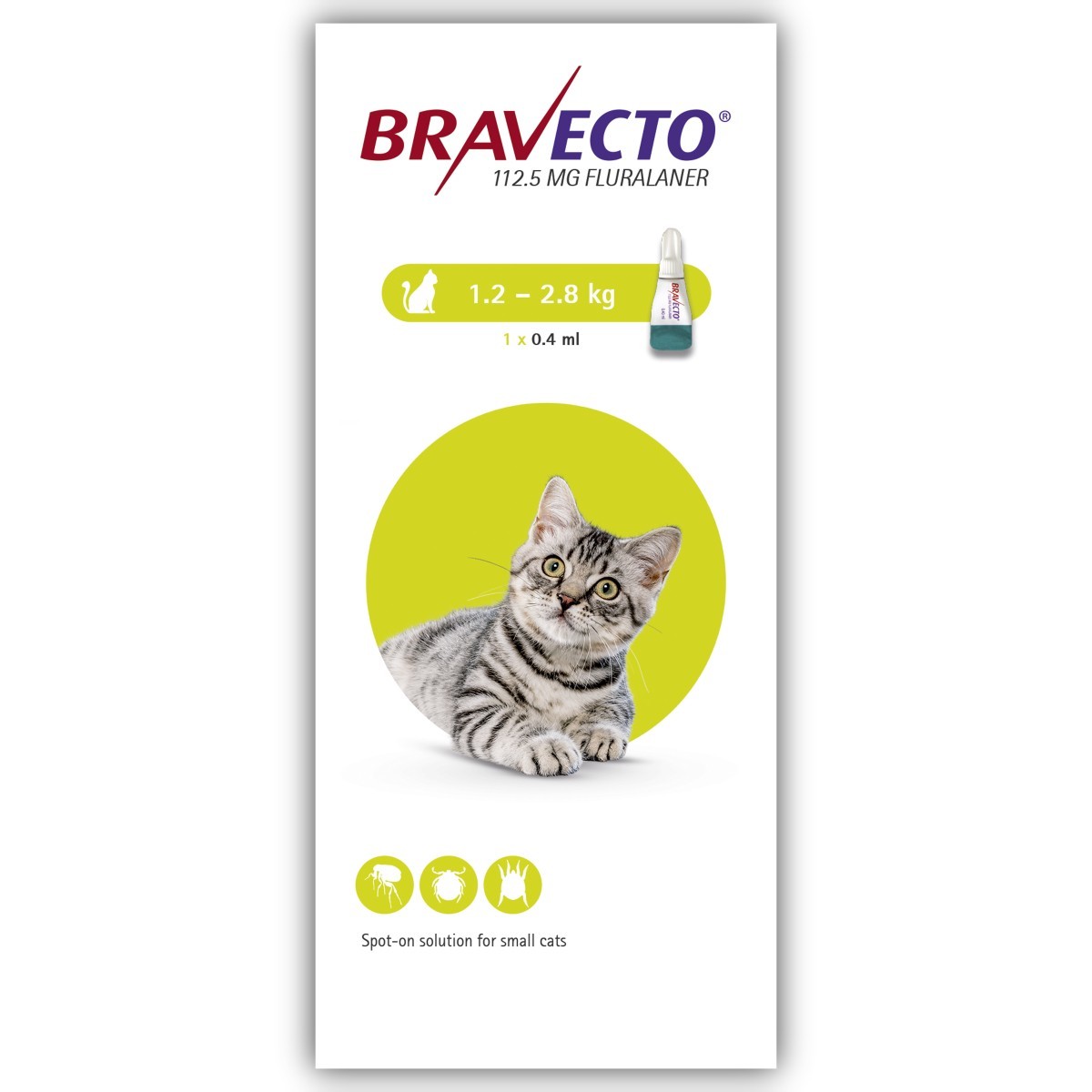Bravecto® Spot-on Solution for Cats Species: Cats Therapeutic indication: Pharmaceuticals: Ectoparasiticides: For dogs, For cats Active ingredient: Fluralaner Product:Bravecto® Spot-on Solution for Cats Bravecto® Spot-on Solution for Cats Product index: Bravecto® Spot-on Solution for Cats Withdrawal notes: Not applicable. Qualitative and quantitative composition Each ml contains 280 mg fluralaner. Each pipette delivers: Pipette content (ml) Fluralaner (mg) For small cats 1.2 - 2.8 kg 0.4 112.5 for medium-sized cats >2.8 - 6.25 kg 0.89 250 for large cats >6.25 - 12.5 kg 1.79 500 For the full list of excipients, see 'Pharmaceutical particulars' section. Pharmaceutical form Spot on solution. Clear colourless to yellow solution. Clinical particulars Target Species Cats. Indications for use For the treatment of tick and flea infestations in cats. This veterinary medicinal product is a systemic insecticide and acaricide that provides immediate and persistent flea (Ctenocephalides felis) and tick (Ixodes ricinus) killing activity for 12 weeks. Fleas and ticks must attach to the host and commence feeding in order to be exposed to the active substance. The product can be used as part of a treatment strategy for the control of flea allergy dermatitis (FAD). For the treatment of infestations with ear mites (Otodectes cynotis). Contraindications Do not use in cases of hypersensitivity to the active substance or to any of the excipients. Special warnings for each target species Parasites need to start feeding on the host to become exposed to fluralaner; therefore the risk of the transmission of parasite borne diseases cannot be excluded. Special Precautions for use Care should be taken to avoid contact with the eyes of the animal. Do not use directly on skin lesions. In the absence of available data, this veterinary medicinal product should not be used on kitten less than 9 weeks old and /or cats weighing less than 1.2 kg. The product should not be administered at intervals shorter than 8 weeks as the safety at shorter intervals has not been tested. This product is for topical use and should not be administered orally. Do not allow recently treated animals to groom each other. Operator warnings Contact with the product should be avoided and disposable protective gloves obtained with this product at the point of sale must be worn when handling the product for the following reasons: •Hypersensitivity reactions have been reported in a small number of people, which can potentially be serious. •Persons with a hypersensitivity to fluralaner or to any of the excipients should avoid any exposure to the product. •The product binds to skin and may also bind to surfaces after spillage of the product. Skin rashes, tingling or numbness have been reported in a small number of individuals after skin contact. If skin contact does occur, wash the affected area immediately with soap and water. In some cases, soap and water are not sufficient to remove the product spilled on the fingers. Contact with the product may also occur when handling the treated animal. Make sure that your animal’s application site is no longer noticeable before resuming contact with the site of application. This includes cuddling the animal and sharing a bed with the animal. It takes up to 48 hours for the application site to become dry but it will be noticeable for longer. If skin reactions occur, consult a physician and show them the product packaging. People with a sensitive skin or known allergy in general e.g. to other veterinary medicinal products of this type should handle the veterinary medicinal product as well as treated animals with caution. This product can cause eye irritation. In case of contact with the eyes, immediately rinse thoroughly with water. This product is harmful after ingestion. Keep the product in the original packaging until use, in order to prevent children from getting direct access to the product. A used pipette should immediately be disposed of. In case of accidental ingestion, seek medical advice and show the package leaflet or the label to the physician. The product is highly flammable. Keep away from heat, sparks, open flame or other sources of ignition.In case of spillage onto, for example table or floor surfaces, remove excess product using paper tissue and clean the area with detergent. Adverse Reactions Mild and transient skin reactions at the application site, such as erythema and pruritus or alopecia were commonly observed in clinical trials (2.2% of treated cats). The following other signs shortly after administration were uncommonly observed: apathy/tremors/anorexia (0.9% of treated cats) or vomiting/hypersalivation (0.4% of treated cats). Convulsions have been reported very rarely based on post marketing safety experience (pharmacovigilance). The frequency of adverse reactions is defined using the following convention: - very common (more than 1 in 10 animals treated displaying adverse reaction(s)) - common (more than 1 but less than 10 animals in 100 animals treated) - uncommon (more than 1 but less than 10 animals in 1,000 animals treated) - rare (more than 1 but less than 10 animals in 10,000 animals treated) - very rare (less than 1 animal in 10,000 animals treated, including isolated reports). Use during pregnancy or lactation The safety of the veterinary medicinal product has not been established during pregnancy and lactation. Use only accordingly to the benefit/risk assessment by the responsible veterinarian. Interactions None known. Fluralaner is highly bound to plasma proteins and might compete with other highly bound active substances such as non-steroidal anti-inflammatory drugs (NSAIDs) and the coumarin derivative warfarin. Incubation of fluralaner in the presence of carprofen or warfarin in dog plasma at maximum expected plasma concentrations did not reduce the protein binding of fluralaner, carprofen or warfarin. During laboratory and clinical field testing, no interactions between Bravecto spot-on solution for cats and routinely used veterinary medicinal products were observed. Amounts to be administered and administration route For spot-on use. Bravecto should be administered in accordance with the following table (corresponding to a dose of 40 - 94 mg fluralaner/kg body weight): Description: Bravecto Cat Dosage Guide For cats above 12.5 kg body weight, use a combination of two pipettes that most closely matches the body weight. Method of administration: Step 1: Immediately before use, open the sachet and remove the pipette. Put on gloves. The pipette should be held by the base or by the upper rigid portion below the cap in an upright position (tip up) for opening it. The twist-and-use cap should be rotated clockwise or counter clockwise one full turn. The cap will stay on the pipette; it is not possible to remove it. The pipette is open and ready for application when the breaking of the seal is felt. Description: Bravecto spot on cat Step 2: The cat should be standing or lying with its back horizontal for easy application. Place the pipette tip on the base of the skull of the cat. Step 3: Squeeze the pipette gently and apply the entire contents directly to the cat’s skin. The product should be applied on cats up to 6.25 kg body weight in one spot at the base of the skull and in two spots on cats greater than 6.25 kg body weight. Description: cat1 Treatment Schedule: For optimal control of tick and flea infestation, the product should be administered at intervals of 12 weeks. For the treatment of ear mite infestations (Otodectes cynotis), a single dose of the product should be applied. A further veterinary examination 28 days after treatment is recommended as some animals may require further treatment with an alternative product. Overdose No adverse reactions were observed following topical administration to kittens aged 9 - 13 weeks and weighing 0.9 - 1.9 kg treated with overdoses of up to 5 times the maximum recommended dose (93 mg, 279 mg and 465 mg fluralaner/kg body weight) on three occasions at shorter intervals than recommended (8-week intervals). Oral uptake of the product at the maximum recommended dose of 93 mg fluralaner/kg body weight was well tolerated in cats, apart from some self-limiting salivation and coughing or vomiting immediately after administration. Withdrawal periods Not applicable.




